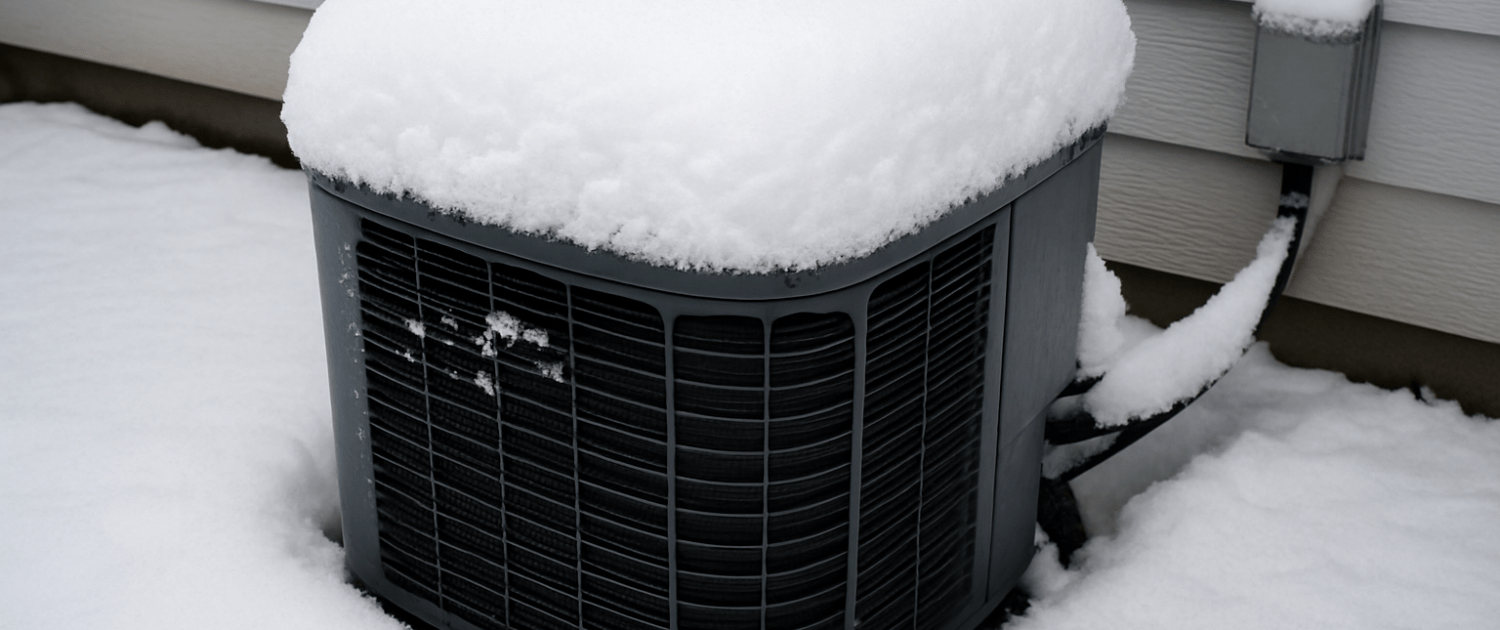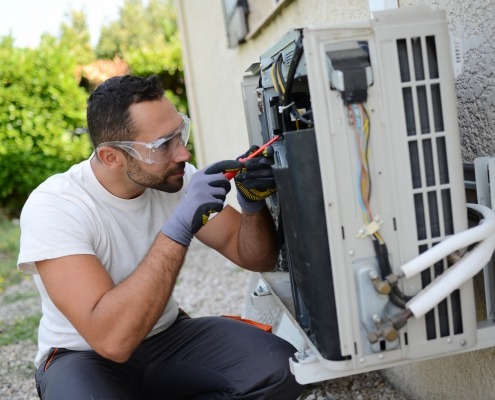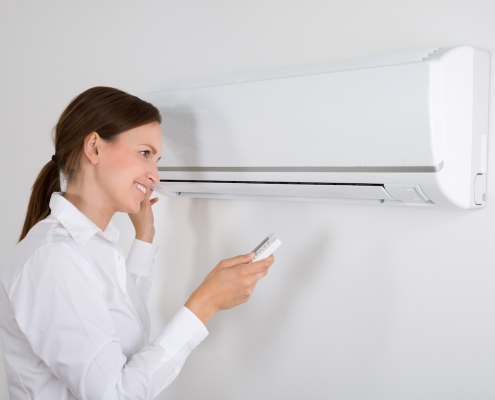Preparing Your Central AC for Winter: A Comprehensive Checklist
Steven E / Wednesday July 2, 2025
As the seasons change and temperatures drop, most homeowners shift their focus from cooling to heating. But before you fire up the furnace and forget about your central air conditioning system for the next few months, take the time to prepare it for winter. We’ll walk you through preparing your central AC system for winter. Here’s everything you need to know to keep your unit in top shape during the off-season.
The information in this article may not apply to your specific appliance model. We recommend consulting your manufacturer’s documentation or contact us with any questions.
Why Winterizing Your AC Matters
Your central air conditioner may not be in use during winter, but it still needs attention. Exposure to cold weather, snow, debris, and rodents can damage outdoor components. Neglecting to clean or inspect the system can lead to corrosion, electrical problems, or system inefficiencies later. By winterizing your AC, you:
- Prevent moisture buildup and corrosion
- Protect electrical components from freezing conditions
- Keep pests from nesting inside your equipment
- Maintain overall efficiency and system reliability
- Ensure a smoother startup when summer returns
Tools and Supplies You May Need
Before you get started, gather the following tools and materials:
- Garden hose with spray nozzle
- Screwdrivers (flathead and Phillips)
- Shop vacuum or soft brush
- AC condenser cover or waterproof tarp
- Foam pipe insulation
- Zip ties or weatherproof tape
- Multimeter (for part testing, if needed)
- Replacement air filter
- Coil cleaner (optional)
- Mild detergent and cloths
Turn Off the Power to the AC System
Start by cutting power to your AC unit. This prevents it from accidentally kicking on during a warm winter day and stops moisture from entering the system during idle cycles.
- Locate the disconnect box near your outdoor condenser unit.
- Open the cover and pull the disconnect or flip the switch to shut off power.
- You can also turn off the breaker labeled for your AC at the main panel as a backup.
Turning off the power protects internal components and helps ensure safety while you work on the system.
Clean the Outdoor Condenser Unit
Before covering your AC, make sure it’s free of dirt, debris, and moisture.
- Remove leaves, twigs, and grass from around the base of the unit.
- Use a garden hose to gently rinse dirt and dust from the exterior coils. Spray from the inside out, using low pressure.
- If coils are especially dirty, apply a coil cleaner, let it sit, then rinse.
- Wipe the top and sides with a damp cloth and mild soap to remove bird droppings or sap.
- Let the unit dry completely before covering it.
Avoid using a pressure washer, excessive force can bend or damage the fins.
Inspect the Unit for Visible Damage
Look for signs of wear or potential issues that should be addressed before winter.
Check for:
- Damaged or bent coil fins
- Cracks or rust spots on the housing
- Loose screws or panels
- Frayed or exposed wiring
- Signs of rodent activity or droppings
Fix minor issues like loose panels or visible debris. If you find wiring damage or a compromised electrical component, make a note to replace or repair it before the next cooling season.
Cover and Protect the Condenser Unit
Covering your AC’s outdoor unit helps protect it from snow, ice, falling debris, and nesting animals. That said, it’s important not to seal the unit completely, as that can trap moisture and promote rust.
Tips for covering your AC:
- Use a breathable cover designed for AC units (not a plastic tarp).
- If using a tarp, leave some space at the bottom to allow airflow.
- Secure the cover with bungee cords or zip ties so it doesn’t blow away.
- Place a piece of plywood and a brick on top if you’re worried about icicles or heavy snow falling from above.
Some homeowners skip the cover altogether in mild climates, but it’s a smart idea if your winters are cold, snowy, or windy.
Insulate the Refrigerant Lines
Your AC’s copper refrigerant lines (running from the condenser to your house) should already be insulated. But the foam insulation can crack or wear down over time.
- Inspect the line set for missing or brittle insulation.
- Replace any damaged insulation with foam pipe wrap or rubber tubing.
- Use weatherproof tape or zip ties to hold it in place.
Protecting these lines prevents energy loss and helps avoid freezing in extreme cold.
Clean or Replace the Air Filter
Even though your AC won’t be running during winter, it’s a good idea to check and replace your HVAC filter now. Many heating systems use the same ductwork and blower as your AC, so airflow remains a shared responsibility.
- Remove the current filter and hold it up to the light.
- If light doesn’t pass through or if it’s visibly dusty, it’s time for a new one.
- Use the correct size and MERV rating for your system.
Changing the filter improves airflow, energy efficiency, and indoor air quality during the heating season.
Inspect the Indoor Parts
Your AC’s indoor components may not be outside in the cold, but they still need some seasonal care. Take a few minutes to:
- Wipe down the air handler or furnace cabinet exterior.
- Vacuum around the base to remove dust and debris.
- Check the drain line or condensate pan for algae or clogs.
- Inspect blower motor wiring and look for signs of overheating or loose connections.
If you have a smart thermostat, you may also want to update settings for heating season or program a new schedule to match your winter lifestyle.
Secure the Area Around Your AC
Winter storms can blow branches, leaves, and other debris into your unit. Keep the area around your condenser clear.
- Trim nearby branches that could drop leaves, snow, or sap.
- Remove or relocate lawn furniture that might get blown into the unit.
- Avoid placing snow shovels, salt bags, or equipment near the AC.
A clean, open space around your AC prevents damage and makes it easier to access when it’s time to uncover it in spring.
Make a Spring Reminder
Once you’ve completed your winter prep, set a reminder for spring to uncover and inspect your AC before turning it back on.
- Add a calendar event or phone reminder for the first warm week of the season.
- Include notes like “Remove AC cover,” “Turn power back on,” and “Inspect drain line.”
You’ll thank yourself later when you’re not scrambling to remember what was covered or disconnected.
Where To Find Us
If you need any replacement parts for your appliances, you can enter your model number at AppliancePartsPros.com to locate and order them quickly. Most orders arrive in just two business days, and we have tons of great information in our repair help section and YouTube videos to help you troubleshoot.
Stay connected with the latest DIY tips, tutorial videos, and repair guides by following us on Facebook, Instagram, and Twitter. We love hearing about your repair stories and successes. If you need more help or want personalized guidance, feel free to reach out. We’re ready to help you take on your next project with confidence!
With nearly a decade of experience in providing top-notch customer service regarding appliance parts and repair, Steven enjoys sharing practical advice, troubleshooting tips, and interesting information to help readers stay informed.





